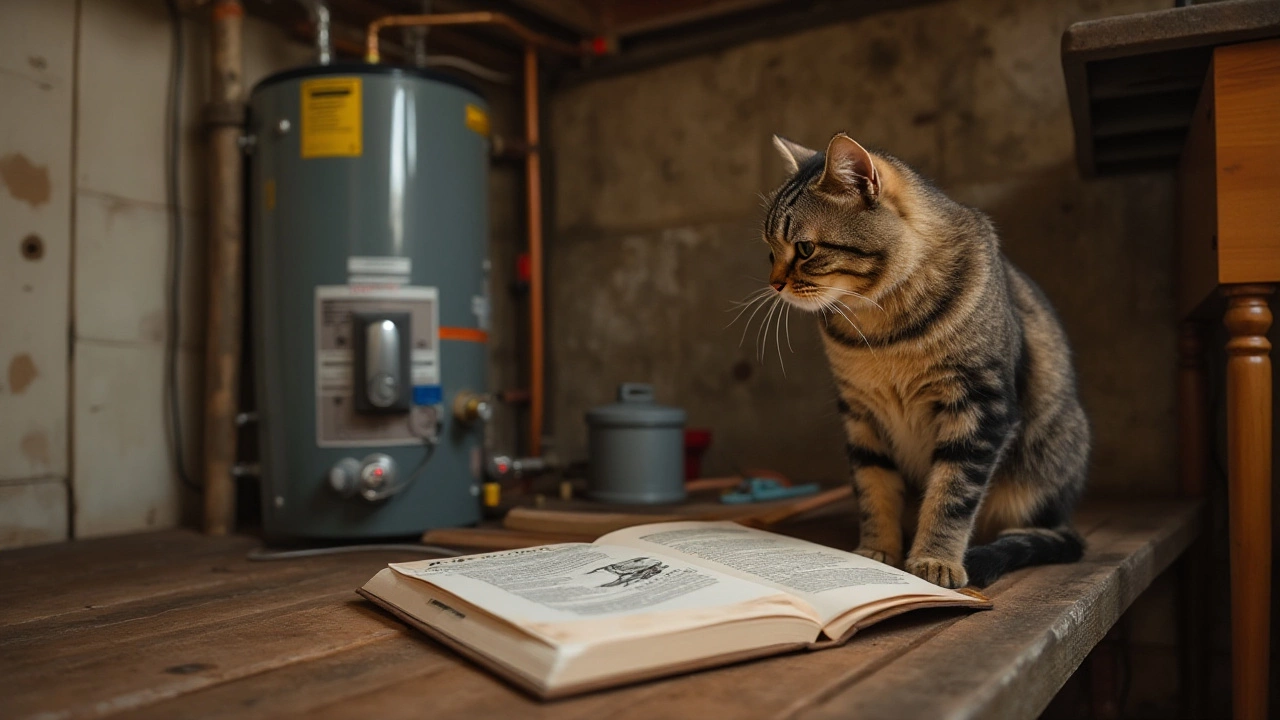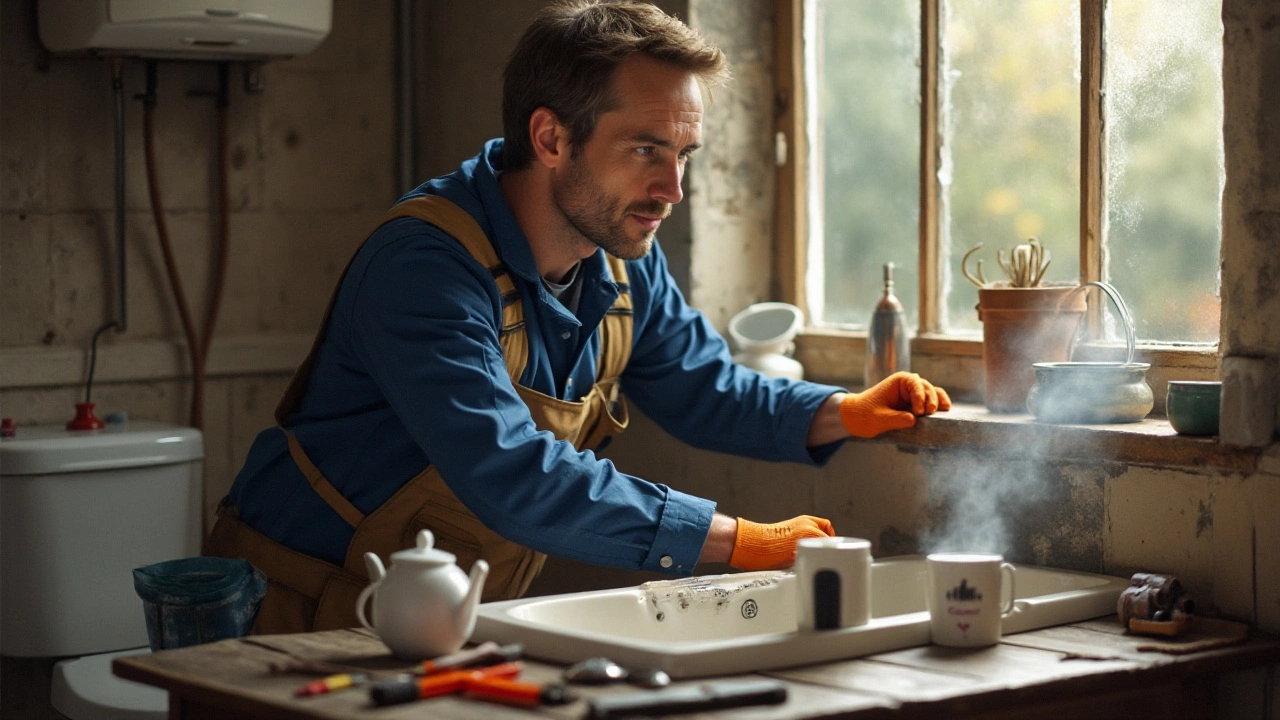When the shower runs cold or the water heater's performance falters, a common reflex is to reach for the reset button. While it might seem like a quick and easy fix, it's important to know when and how to safely reset a water heater. Mistakes can not only lead to damaging the machine but could also pose safety risks.
This article dives into the nuances of resetting a water heater, providing clear and practical advice for homeowners faced with temperamental appliances. We'll cover what you need to know before attempting a reset and when it's wise to seek professional help. Delve into this guide to navigate water heater resets with confidence and caution.
- Understanding Water Heater Basics
- Common Reasons to Reset Your Heater
- Safety Precautions Before Resetting
- Step-by-Step Guide to Safely Reset
- When to Call a Professional
Understanding Water Heater Basics
In many homes, the water heater is a silent guardian, ensuring that hot water is available whenever required. Whether it's for a warm shower on a cold morning or ensuring your dishes are cleaned effectively, a water heater plays a crucial role. But how much do people really know about their water heaters? At the core, a water heater is a simple, yet ingenious invention designed to heat and store water. The tank, often made of steel, is coated with a glass lining to prevent corrosion and insulated to keep water hot efficiently.
The heart of the water heater lies in either the electric heating elements or a gas-fired burner that heats water in the tank. For electric models, there are usually two heating elements—one at the bottom and another near the middle. Gas water heaters, on the other hand, use a burner beneath the tank. Thermostats, located either with the elements or in a separate control box, allow you to control the water temperature. Interestingly, the standard hot water setting is around 120 degrees Fahrenheit, which is hot enough to use effectively and cold enough to prevent scalding.
Another fascinating component of water heaters is the anode rod, a metal stick inserted into the tank to prevent rusting. This sacrificial rod breaks down over time, attracting corrosive elements, thus preserving the life of the tank. Regular maintenance includes checking and potentially replacing this rod, and it's one of the simplest ways to extend the life of your heater.
"A well-maintained water heater can last over a decade, offering reliable service," says John Anderson, a certified home appliance expert. "Ignoring maintenance can lead to inefficiencies or even failures prematurely."
It's also worth noting the importance of the pressure release valve, a safety feature that prevents the tank from over-pressurizing. Understanding how each of these parts works can help you diagnose issues and make informed decisions about when resetting is appropriate. According to the U.S. Department of Energy, heating water accounts for approximately 18% of an average home’s energy use, making the efficient operation of your water heater an important aspect of managing household energy consumption.
Common Reasons to Reset Your Heater
Your water heater is a trusty appliance that works tirelessly to ensure you have hot water at your convenience. However, like any mechanical system, it can sometimes hit a snag and stop performing optimally. There are several common reasons to reset your heater, and understanding them can be the difference between a ten-minute DIY fix and a costly repair bill. Knowing when to press that reset button can help you maintain the overall health of your water heater and extend its life.
One of the most frequent culprits is a tripped thermostat. When the water temperature inside the tank gets too high, the thermostat cuts off power to the heating elements to prevent the unit from overheating. This not only safeguards the appliance but also keeps you from getting scalded in a sudden surge of hot water. Though annoying, it is generally a sign that the safety mechanisms are functioning as they should. Each water heater is built with an inner safety feature that trips the breaker to avoid potential disasters.
Electric supply fluctuations can also lead to the need for a reset. Sudden power interruptions or surges can trick the heater into a fault mode, causing it to shut down. If you've had a recent power outage, your heater might not have restarted automatically, and a manual reset can bring it back to life. Similarly, component wear and tear over years of use can be another reason. Heating elements wear out with time, and as they draw excess power, the system trips as a precaution. A simple reset might temporarily fix the problem, but it could also indicate that you need to plan for component replacement soon.
"Making sure your water heater's thermostat isn't set above 120°F can help prevent frequent resets and also decrease the risk of scalding," says Emily Hersh, a home safety expert.
Another prominent reason behind the necessity for reset comes from mineral build-up and sediment accumulation within the tank, especially in areas with hard water. These sediments can insulate the water from the heating elements, which makes them work harder, overheating and causing the thermostat to trip as a safeguard against high temperatures. Routine flushing of your water heater can help reduce this build-up over time, improving efficiency and reducing unnecessary resets.
Mechanical malfunctions, albeit less common, should not be ruled out. Faulty wiring or broken components could inhibit the heater's performance, causing it to enter a fault mode where a reset seems like a viable solution but doesn’t address the underlying issue. If issues persist after a reset, consider whether it’s time for a professional assessment to prevent more costly and complex problems down the line. To sum it up in a few bold points – thermostat trips, power surges, and sediment build-up are the most frequent reasons to reset your heater.

Safety Precautions Before Resetting
Before you take on the task of resetting your water heater, it’s essential to arm yourself with knowledge about the safety measures that should precede the process. Resetting can indeed be the remedy for your water heater woes, but approaching the task without proper precautions might transform a simple fix into a troublesome ordeal. Always start by turning off the power supply connected to the heater. This vital step ensures that you're not exposed to potential electric shocks during the reset process, significantly lowering the risk factor.
Familiarity with the type of water heater you own is crucial, as different models might require distinct resetting techniques. Examine the unit label or user manual to ascertain specifics. While some heaters may have a clearly marked switch, others may involve more complex procedures. Be sure to inspect for signs of wear and corrosion before diving in. Corroded parts can indicate more severe issues, perhaps making a reset a temporary fix rather than a reliable solution.
It's wise to anticipate the root cause of the heater’s malfunction. Often, faulty thermostats or tripped circuit breakers lead to heater disruptions. If your heater is tripping repeatedly, it is a red flag telling you an underlying issue might require professional intervention. As much as one might feel equipped to tackle home maintenance chores, some problems can spiral out of control if mishandled. Bear in mind that adjusting or tampering with the thermostat without adequate understanding might lead to inefficiency or increased heater energy consumption.
If your skills or knowledge of the machinery are limited, don't hesitate to reach out for expertise. “Better safe than sorry,” says John Sullivan, a renowned energy consultant, who suggests consulting professionals when in doubt.
“Amateur interventions can inadvertently lead to more issues that can compromise both the appliance itself and the individual's safety,”he warns. Consider letting experts diagnose and suggest reliable workarounds. Meanwhile, endeavor to keep yourself secure by wearing protective gear like gloves, especially if parts appear jagged or rusty.
Another pivotal step before resetting is ventilation. Make sure that the water heater is located in a well-ventilated area. Poor ventilation can cause a build-up of harmful gases like carbon monoxide, which poses serious health risks. Regular maintenance checks can prevent these risks from escalating. Additionally, allow the unit to cool down if it has been recently used. Touching a hot water heater can result in burns, and attempting to reset while it’s hot can put undue strain on the components, sometimes making problems worse.
Step-by-Step Guide to Safely Reset
Resetting a water heater might seem like a daunting task, but with the right knowledge, it can be done safely and efficiently. Before you start, it's crucial to understand the importance of taking safety precautions seriously. The first step is always to ensure your safety by turning off the power supply. For electric heaters, this means flipping the breaker switch at the main panel. In the case of gas units, set the thermostat to the lowest setting and extinguish the pilot light.
Once power has been safely disengaged, it's time to perform a quick inspection. Look for any visible signs of damage such as leaks, corrosion, or burnt wiring. These might indicate larger issues that merely resetting won't fix. If everything appears normal, locate the reset button on your heater. This is usually found on the thermostat, often behind a removable panel. Press and hold the reset button for a few seconds. This action could resolve issues related to a tripped internal fuse or thermostat.
After resetting, it's just as important to gradually reintroduce power. For electric heaters, simply turn the breaker back on. For gas heaters, relight the pilot light per the manufacturer's instructions. As your water heater starts up, listen closely for unusual noises that could signal internal issues. Should you notice anything out of the ordinary, it might be time to consult a professional. The performance of your heater after resetting can often provide clues about its condition.
- Ensure all safety protocols are followed.
- Turn off power supplies to avoid accidents.
- Check for any visible damages or leaks.
- Locate and press the reset button securely.
- Gradually restore power and monitor heater performance.
According to home maintenance expert Timothy Wang,
"Resetting a water heater is something most homeowners can handle, but if you’re dealing with frequent resets, it might indicate a deeper underlying problem."Pay attention to how your water heater operates post-reset. If the issue persists, consider reaching out to a technician for a more thorough examination. Readers often find it helpful to understand that safety and caution cannot be overstated when dealing with home appliances.
Remember to consistently monitor your heater even if it's performing normally after a reset. Regular checks can help you maintain your water heater’s efficiency and extend its lifespan. Knowing when to handle things yourself and when to call for professional help ensures that you are not only maintaining your equipment but also safeguarding your home and family.

When to Call a Professional
One might feel tempted to tackle all home repairs personally, partly due to the satisfaction of a DIY fix and cost-saving aspects. However, with complex machines like a water heater, attempting repairs without the right expertise can lead to more harm than good. There are several signs that should prompt you to contact a professional rather than digging deeper into the issue yourself. Let's discuss these signs to help you make an informed decision.
If your water heater frequently requires resetting, despite seemingly operating normally at other times, it could indicate underlying electrical issues that warrant expert attention. Frequent resets could result from thermostats malfunctioning, sediment buildup, or problems with your heating elements. A professional plumber or electrician can conduct thorough tests to pinpoint and address such latent issues, ensuring a smoother, longer-lasting operation.
Next, unusual noises coming from the heater might seem like minor inconveniences, yet they often signal significant inefficiencies. These sounds, often described as popping, rumbling, or banging, usually result from sediment accumulation within the tank. While flushing the tank is the homeowner's way of addressing minor buildups, substantial deposits should be handled by experts who can efficiently and safely clean or, if necessary, replace the affected parts to prevent further damage.
Noticing water pooling around the base of your water heater is another red flag that requires immediate professional attention. Leaks might stem from several causes, including faulty connections, a corroded tank, or a cracked pressure relief valve. This is more than a minor inconvenience; it poses potential safety hazards and risks such as electrical shorts or mold development. Water damage from a neglected leak can lead to extensive home repairs, far beyond merely addressing the faulty appliance.
Speaking of safety, any burning smell or signs of smoke emerging from your water heater should be an immediate cue to disconnect it and call a technician. These indicators suggest severe wiring issues or overheating, which might pose fire hazards. Avoid any attempts to investigate or fix such issues by yourself, as the risks of improper handling are substantial and hit safety concerns at their core.
An insightful conventional wisdom tip comes from a renowned organization like the American Gas Association:
"Gas leaks or unusual pilot light behavior also warrant a prompt professional inspection to prevent serious hazards."Pilot light issues, for both electric and gas water heaters, might point toward issues with the thermocouple or gas supply line, where technical expertise is essential to resolve the situation securely.
Finally, consider age. Water heaters, like any other appliance, have a lifespan. After reaching a decade old, they might start showing signs of irreparable wear. A professional evaluation helps determine the efficacy of further repairs versus the need for a replacement, often allowing homeowners to make economically wise decisions on upgrades or replacements.
Remember, while DIY fixes work for minor glitches or temporary patches, recognizing the necessity of professional intervention can save one from much larger and costly issues down the line.
